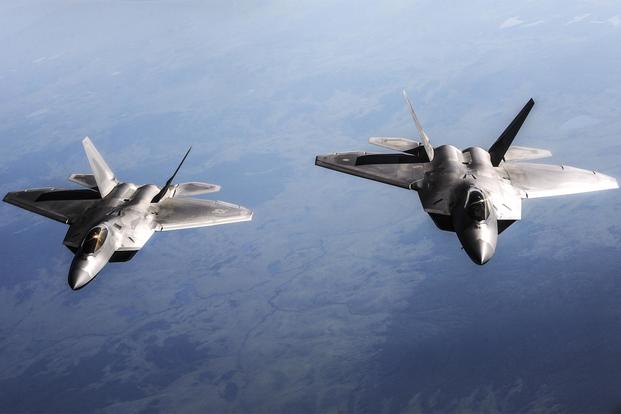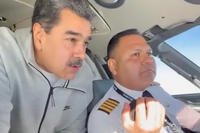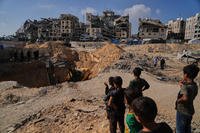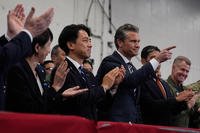The U.S. military's aviation training ranges are outdated and underfunded, leaving pilots operating in the Asia-Pacific region ill-prepared to deal with modern-day threats, a Defense Department investigation found.
Eighteen years of combat missions in the Middle East and the congressional gridlock that has delayed federal budgets have negatively impacted the DoD's aviation range modernization efforts. That has left aviators in the U.S. Indo-Pacific Command training on ranges designed for World War II or Cold War-era threats, according to a once-secret 69-page Defense Department Inspector General report released this week.
"Training ranges and airspace we reviewed did not have the capability or capacity to support aviation readiness for the units assigned to USINDOPACOM," the report states. "Specifically, the training land, airspace, impact areas, and electronic warfare systems were more limited than what was required for training with ordnance used by the aircraft and the aircrafts' capabilities."
The investigation, which focused on helicopters, planes and unmanned aircraft with offensive air support that can attack enemy assets, looked at training ranges in Arizona, Nevada, Hawaii and Alaska. It found capability and capacity gaps at the ranges, which can affect aviation readiness.
Related content:
- Air Force Sees Unique Challenges in Deploying Stealth Fighters
- What It's Like Training Brand-New Air Force Pilots on the F-35A
- Watchdog Slams F-35 Program for Taking Shortcuts That Could Harm Troops
"For example, at the Fallon Range Training Complex [in Nevada], the size of the range limited the use of weapons," the report states. "In another example, the range at the Joint Pacific Alaska Range Complex lacked modern electronic warfare systems, which limited training that pilots received."
Navy and Marine Corps weapons and tactics instructors who've flown combat missions in Iraq and Syria told investigators that several factors at Fallon Range Training Complex make it "too restrictive to use the preferred standoff weapons that are required to defeat a near-peer threat."
Electronic warfare systems there also don't represent current threats, according to the report. Even the newer electronic-warfare systems are low fidelity and don't adequately reproduce sounds and pictures.
Training ranges also aren't big enough to support new state-of-the-art aircraft. Pilots training at Marine Corps Air Station Yuma in Arizona, for example, can't shoot standoff weapons during normal exercises, or fly in fighting formation. They're also limited in where they can train with live ordnance, according to the report.
"The F-35 pilot stated that he could not achieve five of nine mission-essential tasks at Marine Corps Air Station Yuma due to a lack of airspace," it adds. "As a result of the lack of airspace, the pilot stated that F-35 pilots trained in simulators, which could be linked so that the pilots could fly in their four aircraft fighting formation."
Other pilots cited ordnance shortages during training. A Marine AV-8 Harrier pilot said the last time members of Marine Aircraft Group 13 trained with the Joint Direct Attack Munition, a guidance kit that converts unguided bombs into precision-guided "smart" munitions, was in 2016 since they're always needed downrange.
"He stated that, as a result, there was a good chance that Marines would arrive in a combat environment never having trained with the JDAM," the investigator wrote. "He stated that the simulators cannot replicate the missile well enough to provide effective or realistic training."
Soldiers and Marines training in Hawaii also had trouble meeting readiness requirements. Availability and accessibility are limited at the Multipurpose Range Complex at Schofield Barracks on Oahu and the Pohakuloa Training Area on the island of Hawaii.
Apache helicopter pilots training in Alaska said their training area is too narrow to allow for different approaches and that their targets -- dumpsters -- were poor quality. F-35 Joint Strike Fighter and F-22 Raptor pilots also said their aircraft are too sophisticated to recognize the old Soviet-era electronic-warfare systems used at the Joint Pacific Alaska Range Complex.
One example is a Soviet surface-to-air missile system, which represents a 1980s threat, the report states.
Troops training at ranges overseas shared by allies in Japan and South Korea also reported challenges. There are space constraints, outdated electronic-warfare systems and scheduling conflicts. Pilots training in South Korea are concerned about dropping ordnance, for example, because the range is small and surrounded by heavy vegetation.
DoD's inspector general made several recommendations to fix the training problems, including addressing the need for more airspace to train with advanced aircraft and weapons, such as the F-35. The individual services should also review their live and virtual training, according to the report.
The deputy assistant secretary of defense for force education and training concurred with the IG's recommendations.
"We will close the recommendation when we verify ... a plan to field and sustain DoD-wide solutions to address training gaps, including the airspace and impact area needs of advanced aircraft and weapons, such as the F-35; and the need to join neighboring airspace on a continuing basis," the report states.
-- Gina Harkins can be reached at gina.harkins@military.com. Follow her on Twitter @ginaaharkins.














